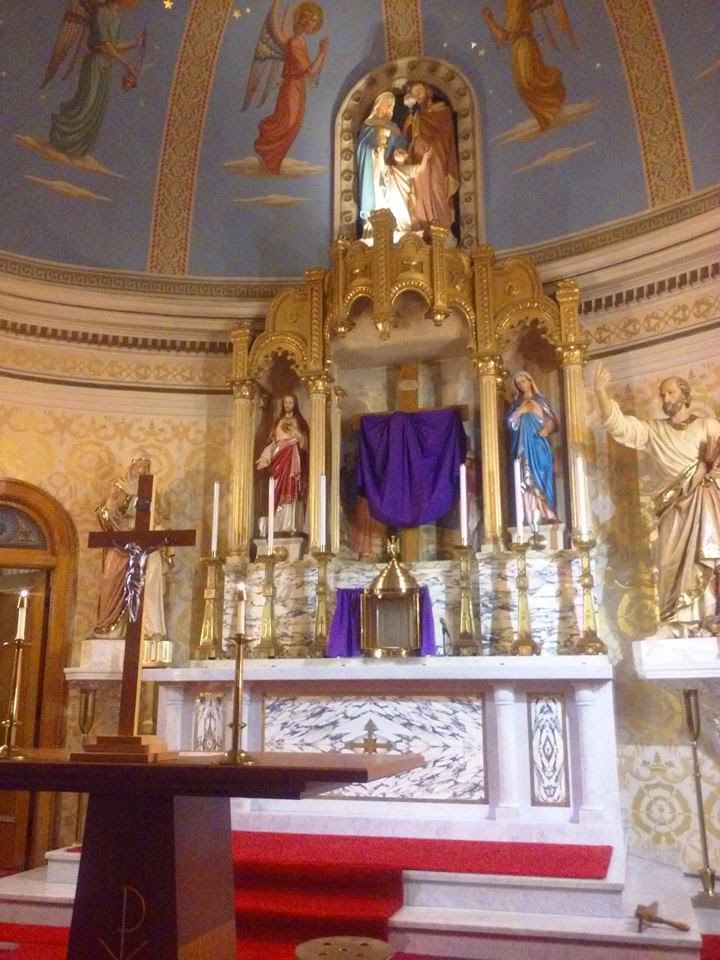In the early 1900s, immigrants from Sicily and southern Italy settled in Detroit. They began to worship at a chapel within Sts. Peter & Paul but, in 1907, Father Giovanni Boschi arrived from Italy and sought to establish an Italian-American parish. On December 7 of that year, Fr. Boschi and 30 laymen formed a committee to begin the process of starting a new parish, at the same time they also formed the Fraternal Order of San Giuseppe.
In 1908, Bishop Foley gave permission to form the new parish of La Chiesa Della Sacra Famiglia or the Church of the Holy Family. A church was designed by architects Edward A. Schilling. Construction began the next year on an Italian Baroque-style church, two blocks northeast of the parent parish. At that time, the street in front of the church was Hastings, long before I-375 was paved.

The brick exterior was originally painted gray but now is beige with white trim. The facade was modeled after two Italian churches: Santa Susanna in Rome and San Marco in Florence.
The small church stands just southeast of Greektown, nestled between the Blue Cross-Blue Shield offices and I-375. Over the main entrance, a segmented pediment frames a limestone medallion. The building is capped by a triangular pediment and a rounded-arched belfry.
A bust of Madonna della Lacrime or, literally, Madonna of the Tears, in the vestibule. A side altar to the Blessed Virgin.
The church includes five altars, four of which depict the Blessed Virgin Mary with symbols of Sicilian towns.
An Immaculate Heart of Mary statue is seated with Child Jesus.
All windows are original to the building; the nave windows show several popular, Italian saints. The clerestory windows show scenes from the life of Christ.
In the clerestory, each window is flanked by an angel on one side and a saint on the other.
Compared to nearby churches, Holy Family is very small and reflects the size of the Italian migration to Detroit. The 1910 Census enumerated just over 6,000 residents with Italy or Sicily as their country of birth. That same year, there were more than eight times as many immigrants born in Germany.
As you might expect, the Holy Family is depicted on the top of the high altar.
Holy Family was added to the Michigan Registry of Historic Sites in 1989 and a plaque was mounted the next year. More than a century after its founding, Holy Family is still heavily identified as Italian. Its one of only two AOD parishes with regularly-scheduled Mass in Italian. The pastor, Fr. Giuseppe Licciardi, is a native of Sicily. Sunday Mass is at 9:30am (Latin) and 11:30am (Italian).
A book about the parish: Detroit's Holy Family Church: 100 Years of Sicilian Tradition
For more info: AOD.org, parish website, & Detroit1701.org
For more photos: Flickr & AOD Film Services
Previous blog post: December 2010

The brick exterior was originally painted gray but now is beige with white trim. The facade was modeled after two Italian churches: Santa Susanna in Rome and San Marco in Florence.
 |
| Santa Susanna, Rome (source) |
 |
| San Marco, Florence (source) |
A bust of Madonna della Lacrime or, literally, Madonna of the Tears, in the vestibule. A side altar to the Blessed Virgin.
The church includes five altars, four of which depict the Blessed Virgin Mary with symbols of Sicilian towns.
All windows are original to the building; the nave windows show several popular, Italian saints. The clerestory windows show scenes from the life of Christ.
In the clerestory, each window is flanked by an angel on one side and a saint on the other.
Compared to nearby churches, Holy Family is very small and reflects the size of the Italian migration to Detroit. The 1910 Census enumerated just over 6,000 residents with Italy or Sicily as their country of birth. That same year, there were more than eight times as many immigrants born in Germany.
As you might expect, the Holy Family is depicted on the top of the high altar.
Holy Family was added to the Michigan Registry of Historic Sites in 1989 and a plaque was mounted the next year. More than a century after its founding, Holy Family is still heavily identified as Italian. Its one of only two AOD parishes with regularly-scheduled Mass in Italian. The pastor, Fr. Giuseppe Licciardi, is a native of Sicily. Sunday Mass is at 9:30am (Latin) and 11:30am (Italian).
A book about the parish: Detroit's Holy Family Church: 100 Years of Sicilian Tradition
For more info: AOD.org, parish website, & Detroit1701.org
For more photos: Flickr & AOD Film Services
Previous blog post: December 2010





















1 comment:
The Church is beautiful! In a world where everything seems to be modern, clinical, cold, and moving at the speed of light, it is refreshing to have a piece of history in all it's glory. A place to slow down and contemplate, a place that reminds us of our past and where we came from. Thanks for sharing with us.
Post a Comment